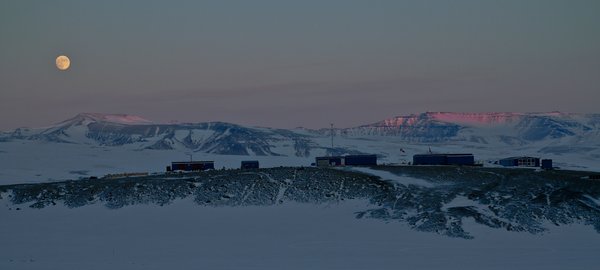Zackenberg Research Station celebrates its 20th anniversary
Zackenberg Research Station celebrates its 20th anniversary
In 1995, visionary researchers established the Zackenberg Research Station in North-East Greenland to monitor climate change in the area. Today – twenty years later – the climate change is precisely described in a unique data set.

Zackenberg Research Station Photo: Henrik Spanggård Munch, Aarhus University
Climate laboratory high up in the north
In the early 1990s, a group of dedicated researchers who shared a fascination with the Arctic went to North-East Greenland. They wanted to build a research station at Zackenberg, 25 kilometres north-west of Daneborg. The stated goal was to monitor the ecosystems on land and at sea to understand their mechanisms over a period of fifty years.
Intensive research efforts are particularly important in the Arctic region because climate change happens twice as fast here as it does in the rest of the world.
Since then, countless Danish and foreign researchers have spent many, many hours in the area, and an extraordinarily large number of scientific publications have seen the light of day with results from here. No other place in the world can provide such quality and duration of time series of a considerable number of different parameters as the Arctic ecosystems on land, in lakes, in the air and at sea.
From tent to hotel
In summer 1995, a group of researchers went to Zackenberg and set up a temporary research station in tents. In the following years, five real buildings were erected, and Zackenberg was extended with a further two buildings in 2010. Zackenberg stands today as a modern research station with all the facilities required to carry out research in a high Arctic area that is not easily accessible. Read about Zackenberg’s history (in Danish only).
Building up and running research stations in this particularly desolate area is quite an accomplishment in itself. Extreme temperatures and inquisitive polar bears make even daily routines quite a challenge.
“We’ve got a lot to thank the early pioneers for. They believed in the idea and braved the harsh conditions. It’s thanks to them that we now have such a unique data set, which makes us better able to predict what will happen with the High Arctic ecosystems along with climate change,” says Niels Martin Schmidt, Aarhus University, who is Zackenberg’s scientific leader.
Change of face in the Arctic
Over the years, the researchers have recorded the growth of animals and plants, and related this to the amount of light, snow, ice and melting from glaciers. Because corresponding studies have been carried out further south in Greenland, the researchers have a number of unique results from different climate conditions.
The research efforts at Zackenberg show that the rises in global temperature have an impact on the ecological balance in the High Arctic in a large number of areas. For example, the research has shown that spring now arrives earlier than it did 20 years ago, and it continues to change. This means that flowers and the insects that pollinate them become out of sync with each other, which creates a chain reaction of effects for the flora and fauna in the area.
The researchers have also studied CO2 and methane emissions from Arctic ecosystems and predict that it will probably be intensified in the warmer climate of the future, when the sea ice melts and the permafrost thaws.
Throughout all its years, the Zackenberg Research Station has been a collaboration between researchers from different Danish and international universities. The research station is owned by the Government of Greenland and is operated by the Department of Bioscience, Aarhus University.
About the Zackenberg Research Station
The Zackenberg Research Station is located at Zackenberg (74º28’ N, 20º34’ W) in North-East Greenland, 25 kilometres north-west of Daneborg. It is used as an ecosystem research and monitoring facility.
The nearest town is Scoresbysund, located 450 kilometres to the south. The station consists of ten buildings at Zackenberg and three at Daneborg – a total of 950 square metres under cover. In addition to accommodation and a canteen, the buildings include laboratories, offices, a storeroom, garage, power plant, workshop and boathouse. The station can accommodate 24 people and has its own landing strip with weekly flight connections during most of the field season, which covers June, July and August. The station is also visited in August by a ship that delivers fuel, spare parts and long-life supplies.
Zackenberg is owned by the Government of Greenland and is operated by the Department of Bioscience, Aarhus University.
The work at Zackenberg is coordinated via the Zackenberg Ecological Research Operations programme, with the following institutions as partners:
Department of Bioscience, Aarhus University
Greenland Institute of Natural Resources
GEUS – Geological Survey of Denmark and Greenland
Research at Zackenberg is financed by:
Danish Ministry of the Environment
Ministry of Higher Education and Science
Naalakkersuisut – Government of Greenland
Aage V. Jensen Charity Foundation
Read more at Zackenberg Research Station
For more information, please contact
Senior Researcher Niels Martin Schmidt
Scientific Leader – Zackenberg Research Station
Department of Bioscience
Aarhus University
nms@bios.au.dk
+45 4191 5664





